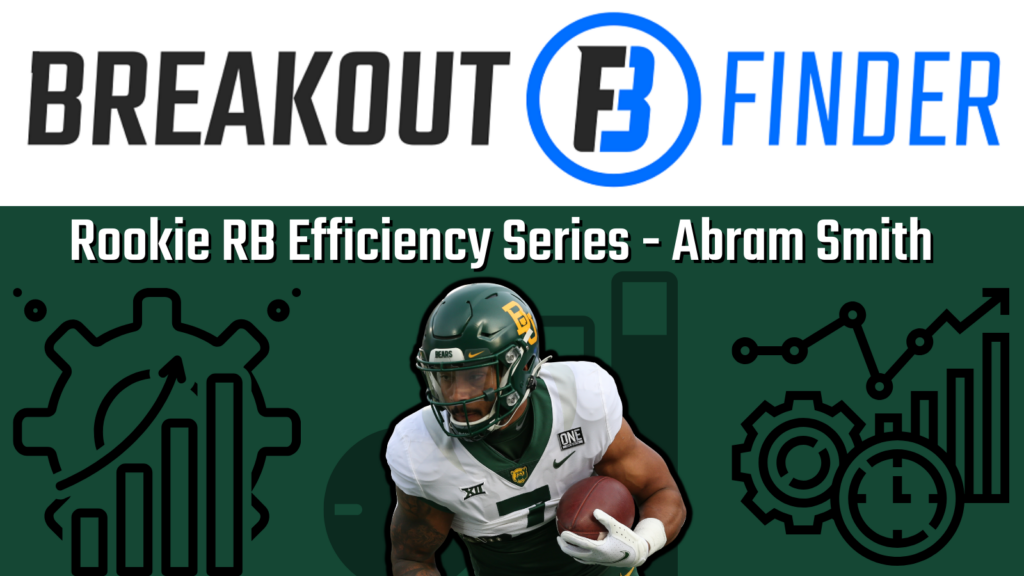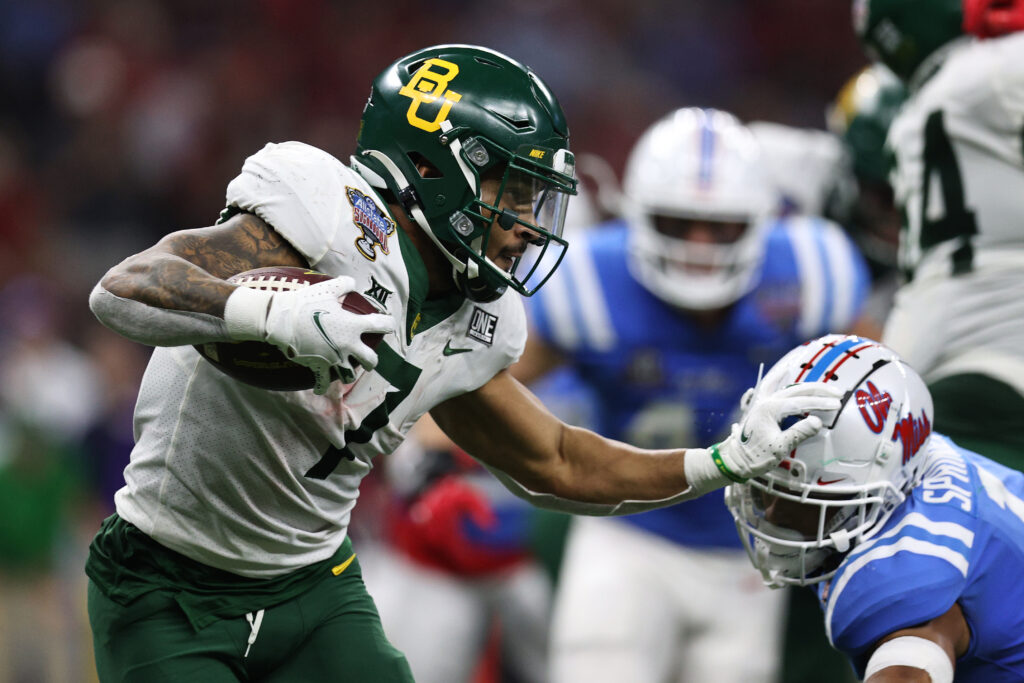This article is part of a series in which I evaluate 2022 rookie running backs solely on their ability to run the ball. The first installments can be found here. If you happened to already catch those and don’t need a refresher on my methodology, feel free to skip to the player-focused analysis below the picture of Baylor’s Abram Smith a couple paragraphs down.

Outside the ability of whoever happens to be running the ball, there is a whole mess of variables that factor into the effectiveness of a given rushing attack: scheme, play-calling tendencies, opponent strength and scheme, weather, offensive line play, surrounding skill-position talent, etc. And given this entanglement, separating the contributions of the ball carrier from the offensive environment in which he operates is not a straightforward task. My approach to doing that is centered around measuring the degree to which a running back is over- or under-performing the per-carry output of the other running backs on his team.
Starting from the premise that good runners do more with what they are given than do bad runners, it stands to reason that, provided players are operating under generally the same conditions (like, for example, playing on the same team), better backs should produce more per carry than lesser backs. Using this logic, we can establish a baseline for comparing efficiency between players on the same team; for each running back, we can compare his performance (X) to the collective performance of every other running back on the team (Y). If X > Y (essentially, if dude is doing more with his carries than his teammates are with theirs), we can probably conclude that the player in question is a good player, at least to some relative degree.
Assuming that this is a sound method of evaluating running backs relative to their teammates, we can then extend our comparisons to players from other teams (we’re really just creating a baseline for efficiency comparisons similar to how Dominator Rating and other market share-based metrics create baselines for volume-based comparisons).
The key metrics I use to evaluate running back performance vs. that of their teammates are called Yards Per Carry+, Chunk Rate+, and a metric I developed recently called Box-Adjusted Efficiency Rating, or BAE. I also like to use a metric called Breakaway Conversion Rate, but that is not a teammate-relative measure and we’ll therefore look into it separately.
The metrics are pretty straightforward: YPC+ is the degree to which a player over- or under-performs his teammates in yards per carry, and Chunk Rate+ is the degree to which a player over- or under-performs his teammates in rate of “chunk” runs (which I classify as runs of 10 yards or more). At a basic level, I want my running back prospects to find a way to produce more per carry than the other backs on the team, and part of that puzzle is navigating the line of scrimmage and extending runs into the secondary at a higher rate than his backfield mates. YPC+ and Chunk Rate+ measure the degree to which a player does both of these things.
BAE also does those things, but it improves upon Yards Per Carry+ by using a weighted average of a player’s per carry efficiency on carries vs. various amounts of defenders in the box (using data from Sports Info Solutions), relative to the per carry efficiency of other running backs on his team vs. the same box counts. The resulting percentage indicates to what degree a runner over- or under-performed his teammates on his total rushing attempts, relative to how often he faced each box count. BAE is a more comprehensive metric than is YPC+, and I will defer to it accordingly, but YPC+ and Chunk Rate+ will still be used given that the sample of data I have for those metrics goes back a decade-plus (while I’m only able to generate BAE Ratings going back to the 2018 college football season).
THE METRICS

Former Baylor Bear Abram Smith is the perfect example of why I’m adding BAE Rating to my running back prospecting repertoire. Based on the YPC+ and Chunk Rate+ metrics, Smith looks like any other JAG-machine volume-guzzler that just compiles yards and touchdowns without actually contributing anything of value to his team’s offense. His career performance (which is essentially just his 2021 performance considering he had 12 carries in three years before handling 257 this season) in YPC+ produces a 39th-percentile mark (among backs drafted since 2007) of 0.26. His career Chunk Rate+ figure of -0.57-percent is in the same ballpark (35th-percentile). What Smith did at Baylor this last season is basically what Damien Harris did at Alabama in his four-year career (0.27 YPC+, -0.53-percent Chunk Rate+), but while Harris was forcing a split decision against teammates in Tuscaloosa that averaged 4.50 stars as high school recruits (a 95th-percentile group), Smith was doing so against backfield mates in Waco that were rated an unspectacular 3.29 stars on average (52nd-percentile). That’s more average than it is bad, but if your per carry output is just about average relative to teammates that are just about average, what can we say about you other than you’re probably just about average?
Box-Adjusted Efficiency Rating says not so fast, my friend. Smith may have outdone other Baylor backs by just 0.26 yards per carry, but he managed to do that against box counts that were 0.33 defenders heavier on average. It’s the highest team-relative box count for any 2022 runner I’ve encountered so far (and higher than the team-relative box counts for A.J. Dillon, Jonathan Taylor, and Javonte Williams during their college careers). Teams were absolutely stacking the line of scrimmage against Smith last year, making him look like that GIF of the Game of Thrones guy with the sword in front of that big army. But he put his head down and just chewed up yardage anyway. Accounting for those heavy box counts in Smith’s efficiency relative to his teammates gives him a BAE Rating of 166.2-percent; the highest mark in the class by far and also the highest career mark I’ve seen, period. My guy was just an absolute animal against defenses geared up to stop him all year.
Putting the team- and box-adjusted stuff aside for a second, Smith was also excellent in the open field, converting chunk runs of 10+ yards into breakaway runs of 20+ yards at a 36.1-percent clip, a 75th-percentile rate. Not only was he fighting through bogs of defenders just to reach the 10-yard mark on his carries, but he was running loose in the secondary once he got there.
TO THE INFALLIBLE RB MODEL
I’m currently workshopping a composite “rushing efficiency score” that uses the box count-adjusted metrics, but an early version of it has Abram Smith as the second-highest rated pure runner in the class. The composite Rushing Efficiency Score that my infallible running back model currently uses (which accounts for all the non-box count metrics touched on in this article, in addition to overall team quality, strength of opponent, offensive line play, and rushing volume) has Smith at a 39.1 out of 100, which is just not good. While I don’t have the sample size to fully jump ship yet, I’m inclined to lean toward the prototype box count-adjusted score that says Smith was a damn good runner last year.

My running back model also generates comps, and per the “pure runner” comp (which uses the same metrics as the Rushing Efficiency Score, in addition to physical attributes like height, weight, and athletic testing numbers), the guys who are most similar to Smith (if we assume he’s a 4.55 guy at the 5-11, 221-pounds he was listed at in 2021) are the above.
LAST WORD
Admittedly, late-bloomer one-hit wonders from non-powerhouse programs are generally JAGs at the next level, and that’s probably Abram Smith‘s most likely career outcome. But if we’re just mining for upside at the end of our rookie drafts, you could do worse than a guy who profiles similarly to Damien Harris, Jay Ajayi, Marion Barber, James Conner, and Le’Veon Bell as a pure runner. If there’s an out-of-nowhere RB2-level producer in this draft class, Smith has as good a shot to be that guy as anybody.
